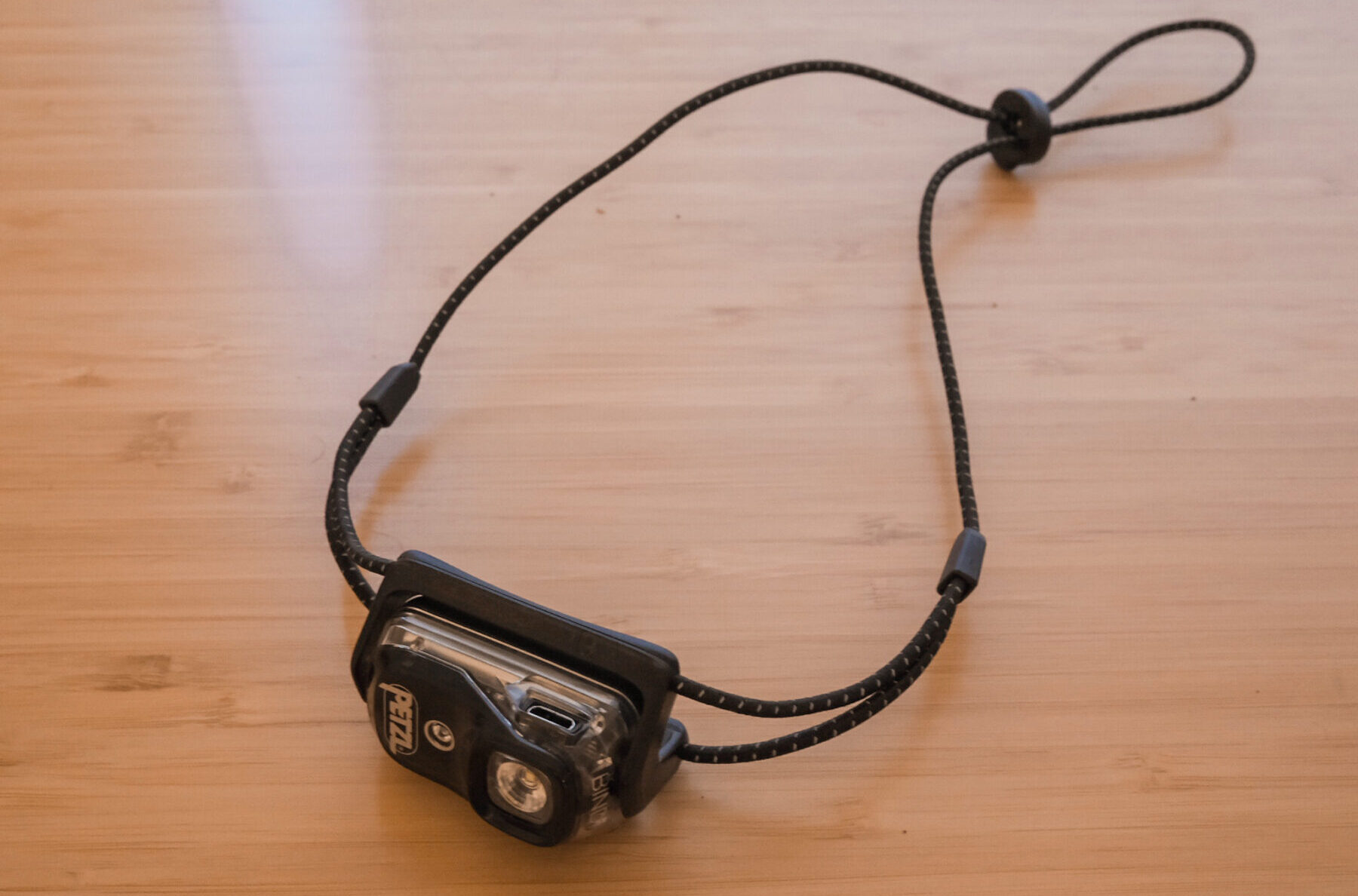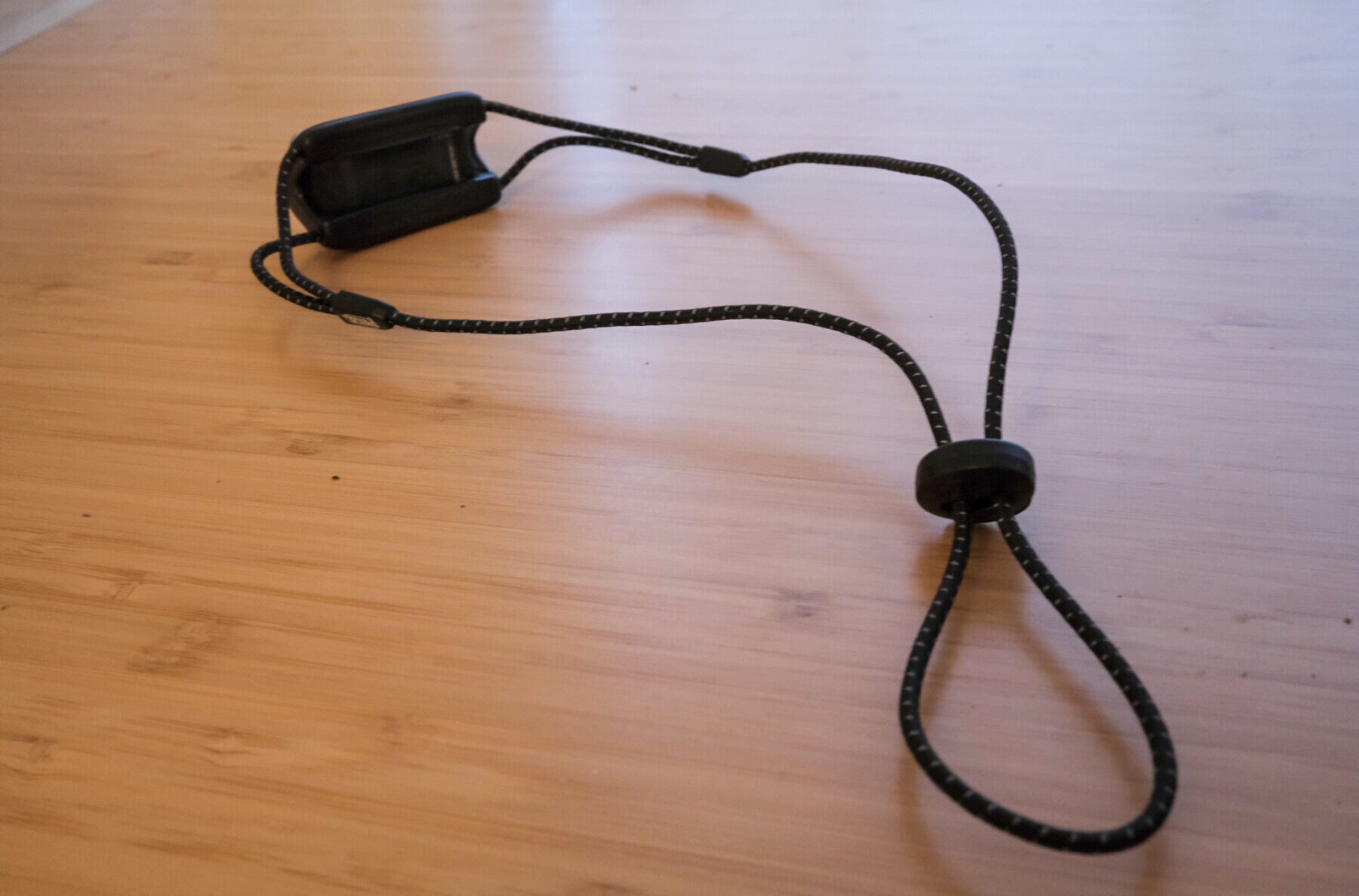Petzl Bindi
Test Location: San Francisco, CA
Test Duration: 500 miles
Size: OSFA
Lumens: 200 lm
Stated Features
- Rechargeable Lithium-Ion 680 mAh battery via micro USB port, with charge indicator
- Two lock functions to avoid accidentally turning it on
- Three lighting levels
- Moisture-wicking headband
- Red lighting with strobe function
- IPX 4 Water Resistance rating
Flood beam pattern

Stated Weight: 35 g
Blister’s Measured Weight: 36 g
MSRP: $44.95
Reviewer: 5’9”, 150 lbs / 175 cm, 68 kg
Intro
The best pieces of gear are often those you forget about, products that integrate so seamlessly into your experience that they become, quite literally, afterthoughts. The most direct route to this point often involves some combination between minimalism and ergonomic design, a balance struck between comfort and efficiency. It’s one of the great paradoxes of running gear, that many of the most admirable examples — be it shoes, apparel, eyewear, etc., — are successful precisely on the merits of their own imperceptibility. For some designers, there’s no higher form of flattery than to hear the phrase, “I forgot I was even wearing it.”
As a not-always covetable accessory, marred by their associations with early morning starts and propensity to flicker out just when you need them most, headlamps face the added challenge presented by how they’re worn. Perched squarely on foreheads, even popular models end up naggingly front of mind, if you will, unable to pass unnoticed during a trail run. Their often rigid frames also make them awkward to carry when not in use; many are too large for a short pocket, yet too diminutive to be thrown into a pack without pinballing around.

Speaking generally, headlamps as a whole have often fallen victim to a “more is better” approach when it comes to lighting power, often much to the detriment of practicality. Most runners who need lighting on a daily basis use headlamps at the edges of the day, either in anticipation of a rising sun or to postpone nightfall. For margins of darkness, many of the options currently available are overkill.
At only 35 g, and with a worthy 200 lumens of brightness, Petzl’s Bindi headlamp is designed for exactly this type of daily use. Carrying on the French brand’s long tradition of producing lightning solutions for anything from cave exploring to climbing expeditions, the Bindi arrived a few years ago as an ultralight, ultra-compact utility option for the less demanding activities that make up the bulk of peoples’ time spent wearing a headlamp. In this review, I’ll go into whether or not I think the Bindi deserves the praise it’s received since its debut and identify where it sometimes struggles, particularly as a running headlamp.
Lighting
Not assuming much from such a petite frame, I looked directly into the Bindi’s lamp when I first turned it on. Taking 200 lumens directly to both corneas filled my eyes with phosphenes as I staggered back, letting out a stoned “woah” in the process. While by no means the most powerful headlamp in Petzl’s lineup, the Bindi is pound for pound one of the strongest. I’m generally not a fan of reading too much into a headlamp’s power, because without context like its weight, intended use, burn time, etc., the amount of lumens it emits is somewhat superficial. What makes the Bindi an attractive lighting option is how it wields those 200 lumens over several modes and settings, indicative of a level of adjustability not commonly seen in headlamps of this size / price point.
Set slightly raised and centered in the Bindi’s plastic frame, the main bulb offers three different white light intensities which can be modulated by clicking through a button positioned on top of the housing. At “Max Burn,” the lamp’s lowest-output setting, Petzl claims you’ll be able to get 50 hours of 6 lm (lumen) light; “Standard Burn” offers 3 hours of 100 lm light; and at “Max Power,” 2 hours of burn time at a full 200 lm. As a preventative against stranding you in the dark, the Bindi also includes 90 minutes of reserve light (3 lm) based on setting, a mode it will automatically switch over to once the battery is close to drained.

One of my main complaints about the Petzl Iko Core (which we reviewed here) was the conspicuous absence of a red light, which, while a secondary feature, goes chronically underappreciated in most headlamps. A red light emits a milder glow than most white beams, in a way that preserves night vision while still roughly illuminating surroundings. Because it’s gentler on the eyes, switching a headlamp into this setting also keeps you from blinding your friends during group runs. The Bindi dedicates a pea-sized LED bulb to its red light, set adjacent to the larger center bulb. When in its main setting, Petzl claims it’s capable of emitting 1 lm of red light for 33 hours, so just enough luminescence to read a map. Toggle to its emergency strobe setting and the Bindi’s red light will blink for a purported 200 hours. Together, the Bindi’s main light and secondary red light play off one another to create a dynamic system appropriate for just about any situation, provided it falls within the headlamp’s battery life.
Fit
The failure of most headlamps actually has nothing to do with their lighting performance; light emission rates ensure a high degree of standardization across models that is hard to defraud. Instead, the locus of complaints generally has much more to do with how well (or how poorly) they fit. That makes sense. Most headlamps are by design going to be slightly unbalanced, with the majority of their weight shifted forward by the frame, battery, and bulb. The elastic straps typically used to offset some of this bias by fixing the headlamp in place often lack the structure and durability required to do so, leading to instability, bouncing, and irritation while running.

Petzl has managed to skirt many of the involved logistics of designing a chassis capable of supporting a heavier lamp by simply stripping the Bindi of any excess weight. Instead of the archetypal elastic headband, Petzl goes with a cinchable elastic cord. In all honesty, I had my doubts about the effectiveness of this decision; small cords don’t often inspire a sense of comfort, and the diameter of the one Petzl uses looked much too thin. However, the lamp’s lack of weight allows the Bindi to rest passively on the head without requiring too much tensioning, as if slightly suspended, and it’s secure enough to stay in place when on the move. The elasticity of the cord should also make the Bindi suitable for most head shapes and allow it to be worn over hats, though its compatibility with helmets might be limited.
The simplicity of this system owes everything to the headlamp’s ultralight, ultra-compact format, something Petzl clearly recognized and took advantage of. I would often find my Bindi still strapped to my forehead hours after finishing a run, having forgotten that I had it on. While that’s a testament to its overall comfort, I do think Petzl could have done well to add a touch of cushioning to the backing of the Bindi’s frame, which is untempered hard plastic. On just a handful of occasions, I noticed reddening on my forehead after a few hours of wear. I expect this had much to do with slight over-tensioning of the elastic cords, but I think the addition of a thin strip of fabric could go a long way in preventing other users from running into similar problems.
Battery Life
Needing light from a headlamp for more than three hours at a time is, in my experience, a rarity for many runners. For most folks, lacing up shoes with the intention of heading out for that amount of time or longer is done with limited frequency, and when done, typically takes place during daylight hours. So unless you’re toeing the line at an ultra that will take you through the night, or you’ve stranded yourself out in the backcountry, lights with really long burn times are likely superfluous, from a purely practical perspective.
The Bindi’s Lithium-Ion 680 mAh micro-USB rechargeable battery, though small by most standards, provides enough power to allow the lamp to serve its purpose as an ultralight recreational option for illuminating short intervals of darkness at the beginnings and ends of runs or other outdoor pursuits where low weight is a priority. However, what I think is more relevant about the Bindi’s battery than its power is the way in which Petzl communicates information through it.

I can’t tell you the number of times I’ve shown up to a trailhead in the dark, reached to click on my light, and found it unresponsive, batteries inexplicably drained. It’s often a test of faith as to whether or not a headlamp is going to have enough juice to power you through a run, a shot in the dark (sorry) I’m never all that excited to take. To combat the uneasiness brought on by doubt as to whether or not you remembered to plug your Bindi in after your last run, it will tell you how charged it is when you first turn it on and as you turn it off. A small light appears for roughly 4 seconds and displays which of the three energy ranges (⅓ charged, ½ charged, fully charged) the battery is currently in.
The headlamp also features two nifty lock settings to prevent it from accidentally being turned on, something that can happen with surprising frequency to lights that spend a lot of time bouncing around pockets or packs when not in use. Holding the top control button for 4 seconds locks the light, and another 4-second hold will subsequently unlock it. For additional security, rotating the Bindi 180 degrees in its frame makes its top control button inaccessible, reducing the likelihood of inadvertently turning it on. These features, including the Bindi’s ability to remember which color mode (red or white) it was in when last used, demonstrate a lot of Petzl’s forethought about how headlamps are used and what information is important. If your Bindi dies in the middle of your run, Petzl doesn’t give you anyone to blame but yourself (provided you’re familiar with its estimated run times / modes, of course).
While I’m generally a huge fan of rechargeable electronics, I think the Bindi’s format is my one major gripe with its design. The headlamp features a fully integrated Lithium battery that, unlike the removable / rechargeable “Core” batteries Petzl uses in models like the Iko and Actik, can’t be swapped out for another Lithium battery or a set of AAA’s; you’re essentially stuck with the same one for the headlamp’s entire lifespan. This has yet to pose any real problems, as I mainly wear the Bindi on short runs close to home, but it’s a frustrating constraint in an otherwise versatile piece of gear. Granted, modularity would likely come at the cost of additional weight, and the Bindi is built to minimize the latter.
Storage and Durability
About half the time I elect to bring a headlamp on a run, I don’t end up using it. Maybe I’ve mistimed the sunrise and can see unassisted by its coronal glow, or I’m headed out into an unfamiliar area and pack a light for emergency use. When a headlamp turns into dead weight, which it often does for me, its heft and shape still matter. Being able to transition efficiently from storage to use is something I consider part of overall performance, and something the Bindi does better than just about every other headlamp of commensurate power I’ve tested. When balled up, its sparse 35 grams occupy no more space than a Zippo lighter, permitting it to slip into most short pockets without noticeably protruding or knocking around. The Bindi is so slight, in fact, that I’ve settled into just leaving it strapped to my head when not in use, which says a lot, given my aversion to wearing headlamps to begin with.

On Trail
Trail runners have a reputation for being pretty spartan when it comes to carrying extraneous equipment. Not only does it not look cool to have accessories spilling from pockets and packs, but for many, it compromises their reason to run in the first place: to feel untethered, free of restraints for a brief period of time. As a sometimes necessary piece of gear, the Bindi is a reliable tool that serves its purpose well, but arguably more importantly, it doesn’t interfere with the independence running inspires.
My time with the Bindi only reaffirmed these notions. Prior to daylight savings last year, mine lived in my car, where I’d charge it during my commute to predawn trail runs with friends prior to donning it for anywhere between 1 to 2 hours at a time. At its Standard Burn setting (100 lm), I had no issues navigating even the most technical singletrack, which appeared fully defined under the Bindi’s flood lighting. As the night sky paled at the pace of the encroaching sun, I’d regularly toggle to the headlamp’s Max Burn setting (6 lm) to extend battery life, before then switching to the Bindi’s red light when I caught up to my friends taking a breather. The simplicity afforded by having just one control button made switching between settings effortless while on the move, something I’ve struggled to nail with more involved headlamps that ask you to perform a series of clicks to adjust their intensities.

Who’s It For?
A more intriguing line of inquiry might be, “Who is the Bindi not for?” As an ultralight, ultra-compact headlamp with a strong enough bulb to light up even the darkest of trails and a burn time well within the duration of most peoples’ runs, the Bindi makes sense, well, for a ton of people. Making blanket statements like that is something I typically refrain from doing, but in this case, I think it’s appropriate, with a slight qualification. Obviously, if you’re in need of a light to get you through the night, the Bindi’s short battery life disqualifies it as a viable option. However, at a puny 35 g and an affordable price point, stashing a Bindi in your pack as an emergency backup could save you some grief, especially if you’re like me and habitually forget to charge your electronics. So yeah, as a main option for pre-dawn / post-dusk weekday runs, outings for which bringing a headlamp isn’t required but probably a good idea, or as a backup to a more powerful light during an all-night effort, the Bindi will find a use, one way or another. If you’re in need of a super powerful light (e.g., for higher-speed activities like biking) or one with extended battery life, Petzl and other brands make better alternatives.
Bottom Line
The Petzl Bindi is one of the most practical headlamps we’ve tested, ideal for short to medium-duration trail runs in the dark up to 3 hours, and/or as an emergency backup for longer efforts. Beyond its 35 grams and 200 lumens of brightness, impressive stats in their own right, Petzl has gone to lengths to pack the headlamp’s tiny frame full of as many features as possible, including several light settings, lock functions, and a handy red light. While we’re disappointed that a replaceable battery wasn’t among them, the Bindi is still a reliable lighting option for any level of runner logging miles before sunrise or after sunset.
